Employing Artificial Intelligence for Enhanced Microbial Fuel Cell Performance through Wolf Vitamin Solution Optimization
Abstract
1. Introduction
2. Materials and Methods
2.1. Enrichment
2.2. Analysis and Calculations
2.3. Adaptive Boosting (AdaBoost)
- Identifying weights: wj = , j = 1, 2, …, n;
- At each iteration, the training data are set to a weak learner using weights, and the weighted error is calculated;
- For each i, specify weights for predictors ;
- Modify data weights for each i to N (N is the number of learners);
- As an output, change the weak learner for the data test (x).
2.4. Extreme Gradient Boosting (XGBoost)
2.5. Categorical Boosting (CatBoost)
2.6. Support Vector Regression (SVR)
3. Results
3.1. Attachment of Microorganisms
3.2. Soft Computing Results
3.3. Optimization
4. Conclusions
Author Contributions
Funding
Institutional Review Board Statement
Informed Consent Statement
Data Availability Statement
Conflicts of Interest
References
- Sharif, H.M.A.; Farooq, M.; Hussain, I.; Ali, M.; Mujtaba, M.; Sultan, M.; Yang, B. Recent innovations for scaling up microbial fuel cell systems: Significance of physicochemical factors for electrodes and membranes materials. J. Taiwan Inst. Chem. Eng. 2021, 129, 207–226. [Google Scholar] [CrossRef]
- Rejano, C.J.F.; Chen, B.-Y.; Sobremisana, G.S.; Tayo, L.L.; Wang, K.-T.; Tsai, P.-W. Electrochemical analysis via microbial fuel cells reveals electron-stimulating characteristics, immunomodulation and antiviral properties of Ji Qin Yin. J. Taiwan Inst. Chem. Eng. 2023, 152, 105193. [Google Scholar] [CrossRef]
- Ghasemi, M.; Qazani, M.R.C.; Lennon, C.W.; Sedighi, M. Analysis and prediction of microbial fuel cell behaviour using MLP and SVR. J. Taiwan Inst. Chem. Eng. 2023, 151, 105101. [Google Scholar] [CrossRef]
- Khater, D.Z.; El-Khatib, K.M.; Hassan, R.Y.A. Effect of vitamins and cell constructions on the activity of microbial fuel cell battery. J. Genet. Eng. Biotechnol. 2018, 16, 369–373. [Google Scholar] [CrossRef]
- Islam, J.; Chilkoor, G.; Jawaharraj, K.; Dhiman, S.S.; Sani, R.; Gadhamshetty, V. Vitamin-C-enabled reduced graphene oxide chemistry for tuning biofilm phenotypes of methylotrophs on nickel electrodes in microbial fuel cells. Bioresour. Technol. 2020, 300, 122642. [Google Scholar] [CrossRef] [PubMed]
- Becker, J.; Liebal, U.W.; Phan, A.N.T.; Ullmann, L.; Blank, L.M. Renewable carbon sources to biochemicals and -fuels: Contributions of the smut fungi Ustilaginaceae. Curr. Opin. Biotechnol. 2023, 79, 102849. [Google Scholar] [CrossRef] [PubMed]
- Hu, X.; Tan, X.; Shi, X.; Liu, W.; Ouyang, T. An integrated assessment of microfluidic microbial fuel cell subjected to vibration excitation. Appl. Energy 2023, 336, 120852. [Google Scholar] [CrossRef]
- Agrawal, K.; Nair, L.G.; Chaturvedi, V.; Verma, P. Designing microbial cellulases using genetic engineering approach: A promising strategy towards zero-waste cellulosic biorefinery. Biocatal. Agric. Biotechnol. 2023, 52, 102830. [Google Scholar] [CrossRef]
- Yang, Y.-R.; Guo, Y.-X.; Wang, Q.-Y.; Hu, B.-Y.; Tian, S.-Y.; Yang, Q.-Z.; Cheng, Z.-A.; Chen, Q.-J.; Zhang, G.-Q. Impacts of composting duration on physicochemical properties and microbial communities during short-term composting for the substrate for oyster mushrooms. Sci. Total Environ. 2022, 847, 157673. [Google Scholar] [CrossRef] [PubMed]
- Song, B.; Li, Z.; Li, S.; Zhang, Z.; Fu, Q.; Wang, S.; Li, L.; Qi, S. Functional metagenomic and enrichment metatranscriptomic analysis of marine microbial activities within a marine oil spill area. Environ. Pollut. 2021, 274, 116555. [Google Scholar] [CrossRef]
- Mohyudin, S.; Farooq, R.; Jubeen, F.; Rasheed, T.; Fatima, M.; Sher, F. Microbial fuel cells a state-of-the-art technology for wastewater treatment and bioelectricity generation. Environ. Res. 2022, 204, 112387. [Google Scholar] [CrossRef]
- Sayed, E.T.; Rezk, H.; Abdelkareem, M.A.; Olabi, A.G. Artificial neural network based modelling and optimization of microalgae microbial fuel cell. Int. J. Hydrogen Energy 2023, 52, 1015–1025. [Google Scholar] [CrossRef]
- Lee, M.K.; Allareddy, V.; Rampa, S.; Elnagar, M.H.; Oubaidin, M.; Yadav, S.; Rengasamy, S. Applications and Challenges of Implementing Artificial Intelligence in Orthodontics: A Primer for Orthodontists. Semin. Orthod. 2024, 30, 72–76. [Google Scholar] [CrossRef]
- Asadi, M.R.; Ghasabehi, M.; Ghanbari, S.; Shams, M. The optimization of an innovative interdigitated flow field proton exchange membrane fuel cell by using artificial intelligence. Energy 2024, 290, 130131. [Google Scholar] [CrossRef]
- Available online: https://onlinelibrary.wiley.com/doi/10.1002/er.5484 (accessed on 24 July 2024).
- Cheng, C.-Y.; Chung, F.-Y.; Chou, P.-Y.; Huang, C. Surface modification of polytetrafluoroethylene by atmospheric pressure plasma-grafted polymerization. Plasma Chem. Plasma Process. 2020, 40, 1507–1523. [Google Scholar] [CrossRef]
- Abdollahfard, Y.; Sedighi, M.; Ghasemi, M. A New Approach for Improving Microbial Fuel Cell Performance Using Artificial Intelligence. Sustainability 2023, 15, 1312. [Google Scholar] [CrossRef]
- Freund, M. Functional dissociations revealed by representational similarity analysis of color-word Stroop. Master’s Thesis, Washington University in St. Louis, Saint Louis, MO, USA, 2019. [Google Scholar]
- Yilmaz, U.; Turksoy, O. Artificial intelligence based active and reactive power control method for single-phase grid connected hydrogen fuel cell systems. Int. J. Hydrogen Energy 2023, 48, 7866–7883. [Google Scholar] [CrossRef]
- Mohammadi, M.-R.; Hadavimoghaddam, F.; Pourmahdi, M.; Atashrouz, S.; Munir, M.T.; Hemmati-Sarapardeh, A.; Mosavi, A.H.; Mohaddespour, A. Modeling hydrogen solubility in hydrocarbons using extreme gradient boosting and equations of state. Sci. Rep. 2021, 11, 17911. [Google Scholar] [CrossRef]
- Homafar, A.; Nasiri, H.; Chelgani, S.C. Modeling coking coal indexes by SHAP-XGBoost: Explainable artificial intelligence method. Fuel Commun. 2022, 13, 100078. [Google Scholar] [CrossRef]
- Hong, Z.; Tao, M.; Liu, L.; Zhao, M.; Wu, C. An intelligent approach for predicting overbreak in underground blasting operation based on an optimized XGBoost model. Eng. Appl. Artif. Intell. 2023, 126, 107097. [Google Scholar] [CrossRef]
- Ge, Z.; Feng, S.; Ma, C.; Wei, K.; Hu, K.; Zhang, W.; Dai, X.; Fan, L.; Hua, J. Quantifying and comparing the effects of key chemical descriptors on metal–organic frameworks water stability with CatBoost and SHAP. Microchem. J. 2024, 196, 109625. [Google Scholar] [CrossRef]
- Wang, Z.; Li, C.; Liu, Y.; Wu, Y.; Zhang, S.; Deng, C. Atomically dispersed Fe-Ni dual sites in heteroatom doped carbon tyres for efficient oxygen electrocatalysis in rechargeable Zn-Air battery. J. Energy Chem. 2023, 83, 264–274. [Google Scholar] [CrossRef]
- Chin, W.L.; Kee, P.E.; Ng, H.S.; Lan, J.C.-W.; Tan, J.S. Selective screening Lactobacillus spp. against Escherichia coli and Salmonella typhimurium and optimizing a cane molasses-based medium with Lactobacillus acidophilus as a guiding model. J. Taiwan Inst. Chem. Eng. 2023, 160, 105197. [Google Scholar] [CrossRef]
- Singh, A.; Rao, A.; Kaushik, A. Achieving high electrogenic output from microbial fuel cell by chloroform-biotin pretreatment of wetland soil inoculum. J. Environ. Chem. Eng. 2023, 11, 109403. [Google Scholar] [CrossRef]
- Ghasemi, M.; Rezk, H. Performance improvement of microbial fuel cell using experimental investigation and fuzzy modelling. Energy 2024, 286, 129486. [Google Scholar] [CrossRef]
- Santos, J.S.; Tarek, M.; Sikora, M.S.; Praserthdam, S.; Praserthdam, P. Anodized TiO2 nanotubes arrays as microbial fuel cell (MFC) electrodes for wastewater treatment: An overview. J. Power Source 2023, 564, 232872. [Google Scholar] [CrossRef]
- Li, K.-Q.; Yin, Z.-Y.; Zhang, N.; Liu, Y. A data-driven method to model stress-strain behaviour of frozen soil considering uncertainty. Cold Reg. Sci. Technol. 2023, 213, 103906. [Google Scholar] [CrossRef]
- Han, J.-Y.; Zhang, H.-L.; Guo, H.; Liu, A.-Q.; Nawab, S.; Liu, N.; Hui, M.; Zhai, D.-D.; Yong, Y.-C. A rational designed synthetic three-species alliance system for synergetic improvement on power generation from microbial fuel cell. Chem. Eng. J. 2023, 481, 148366. [Google Scholar] [CrossRef]
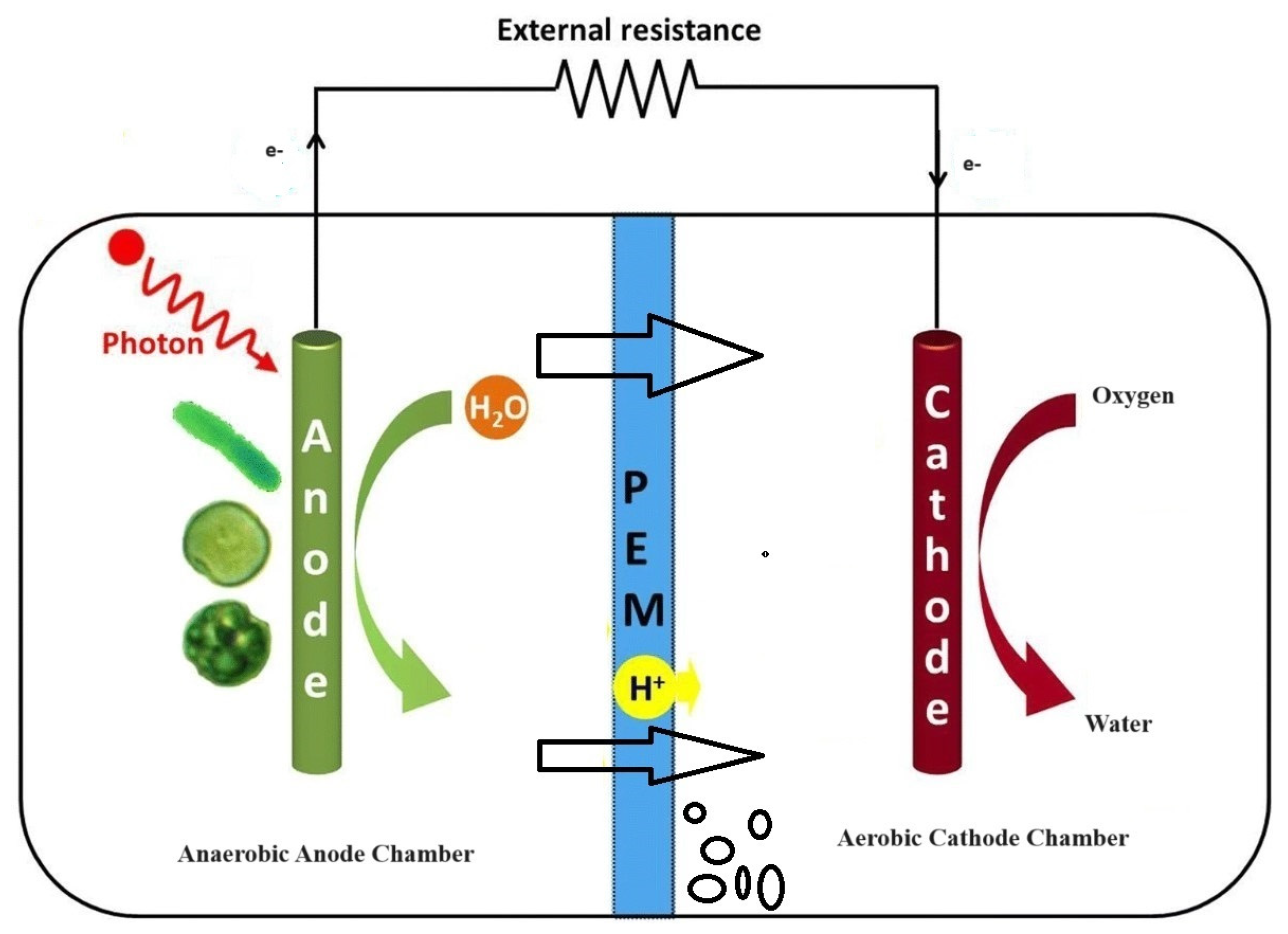
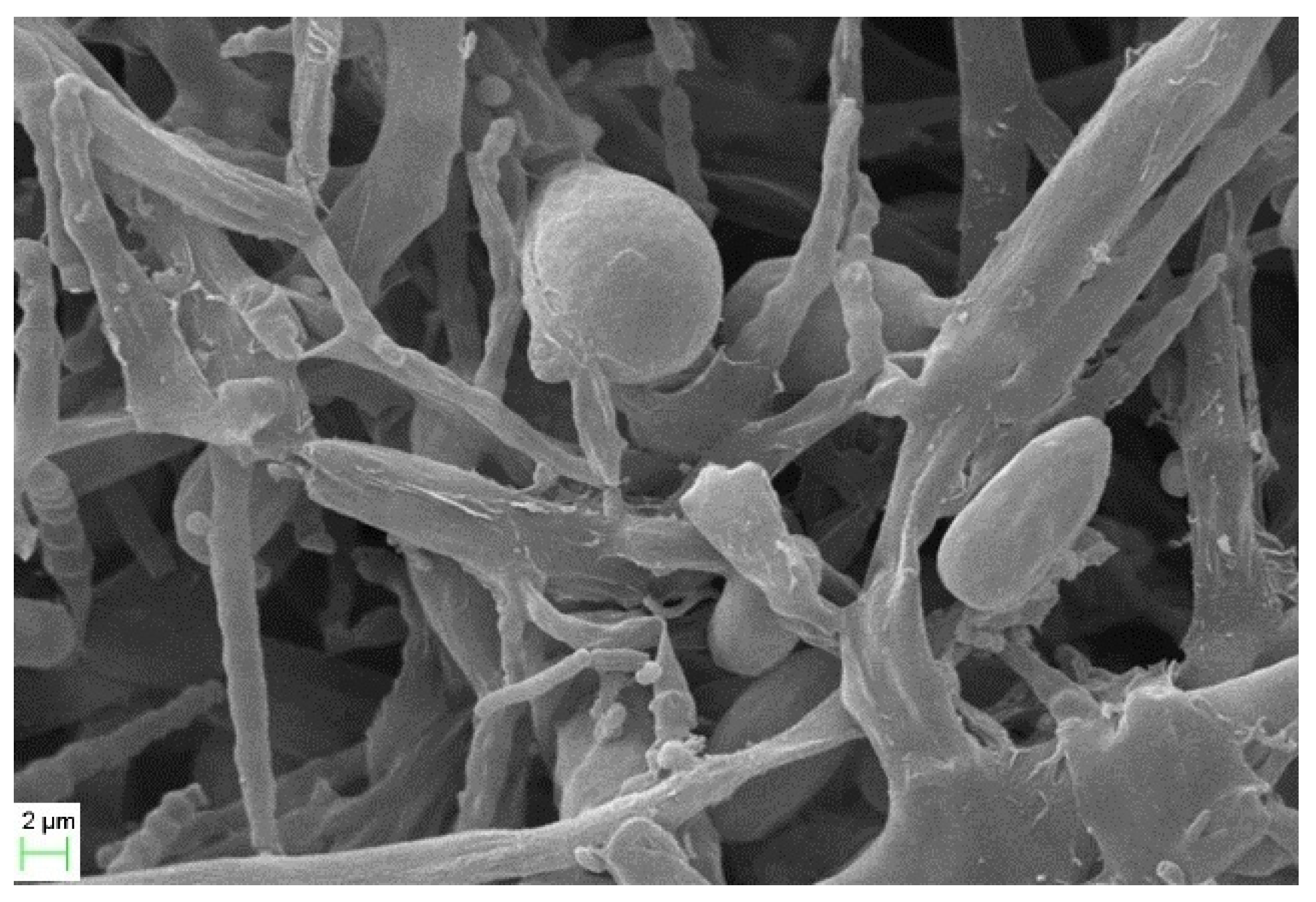
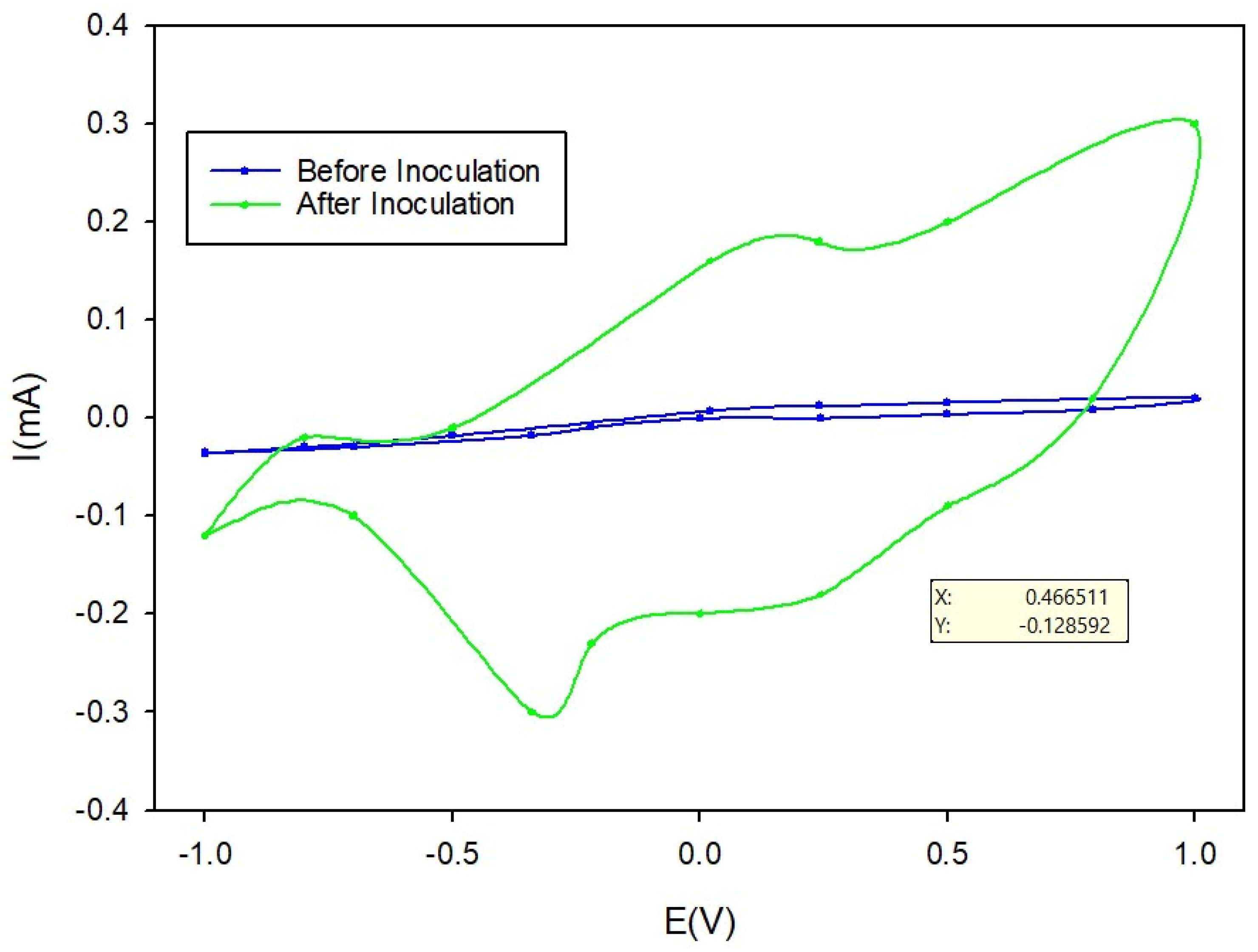
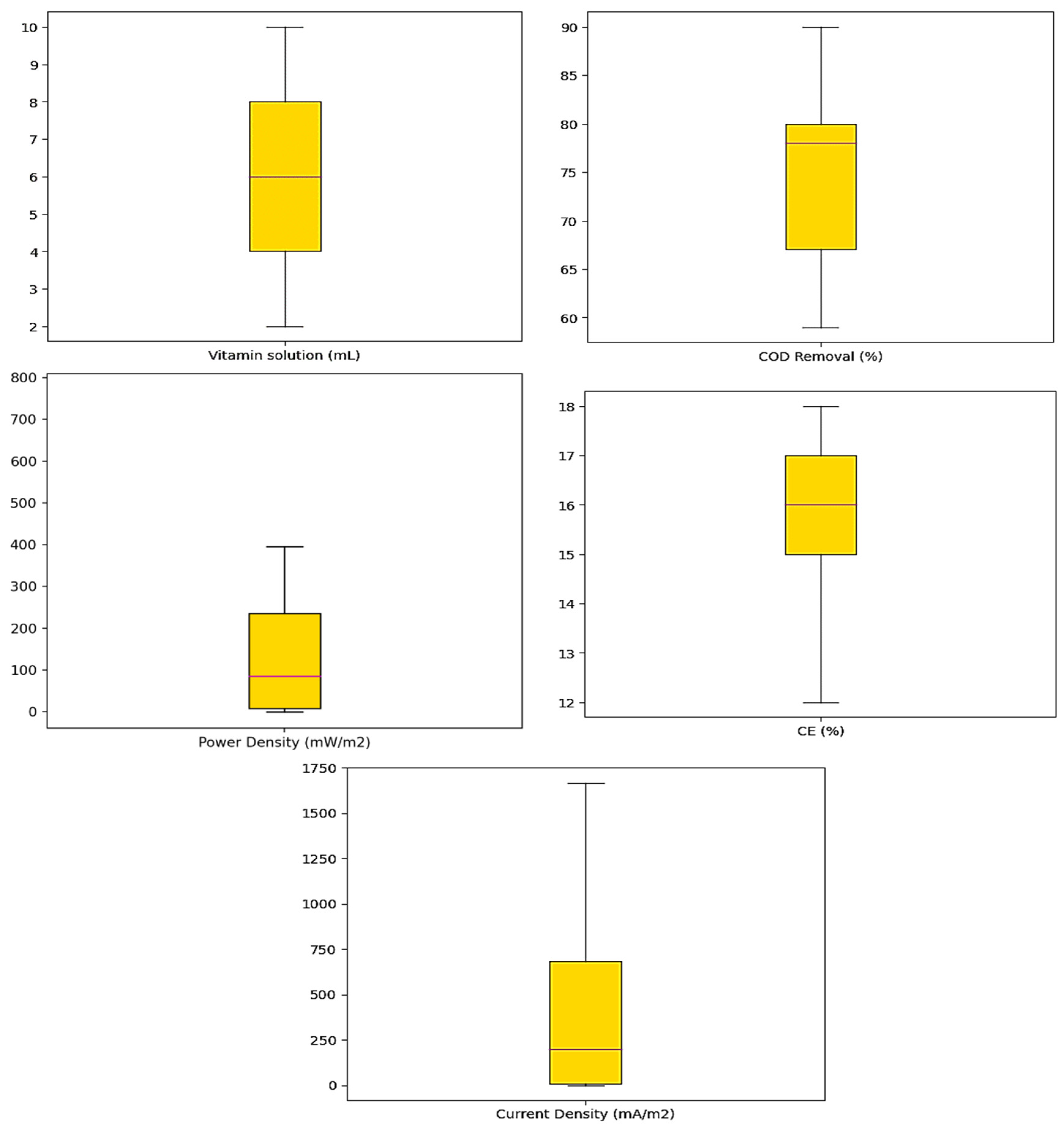
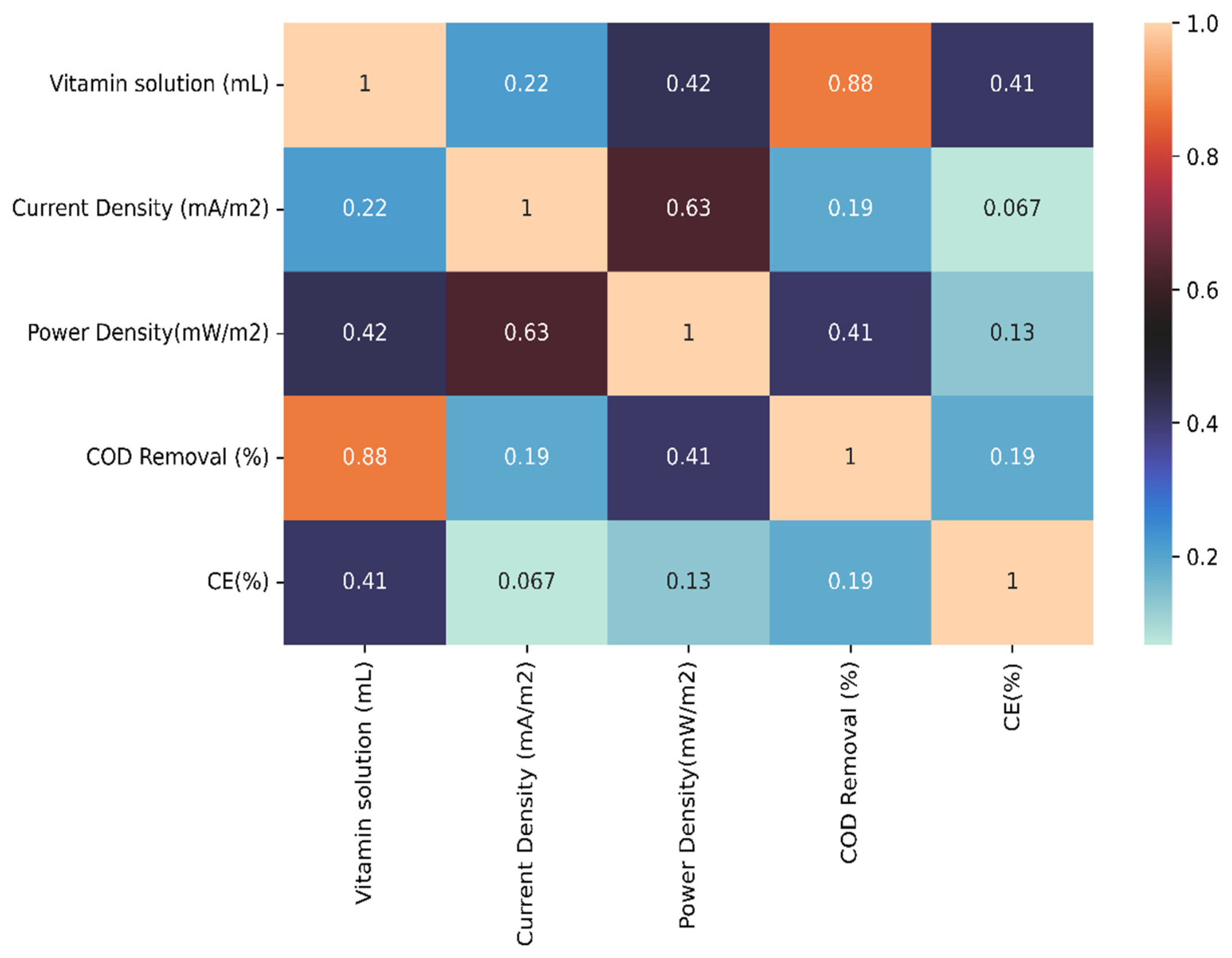
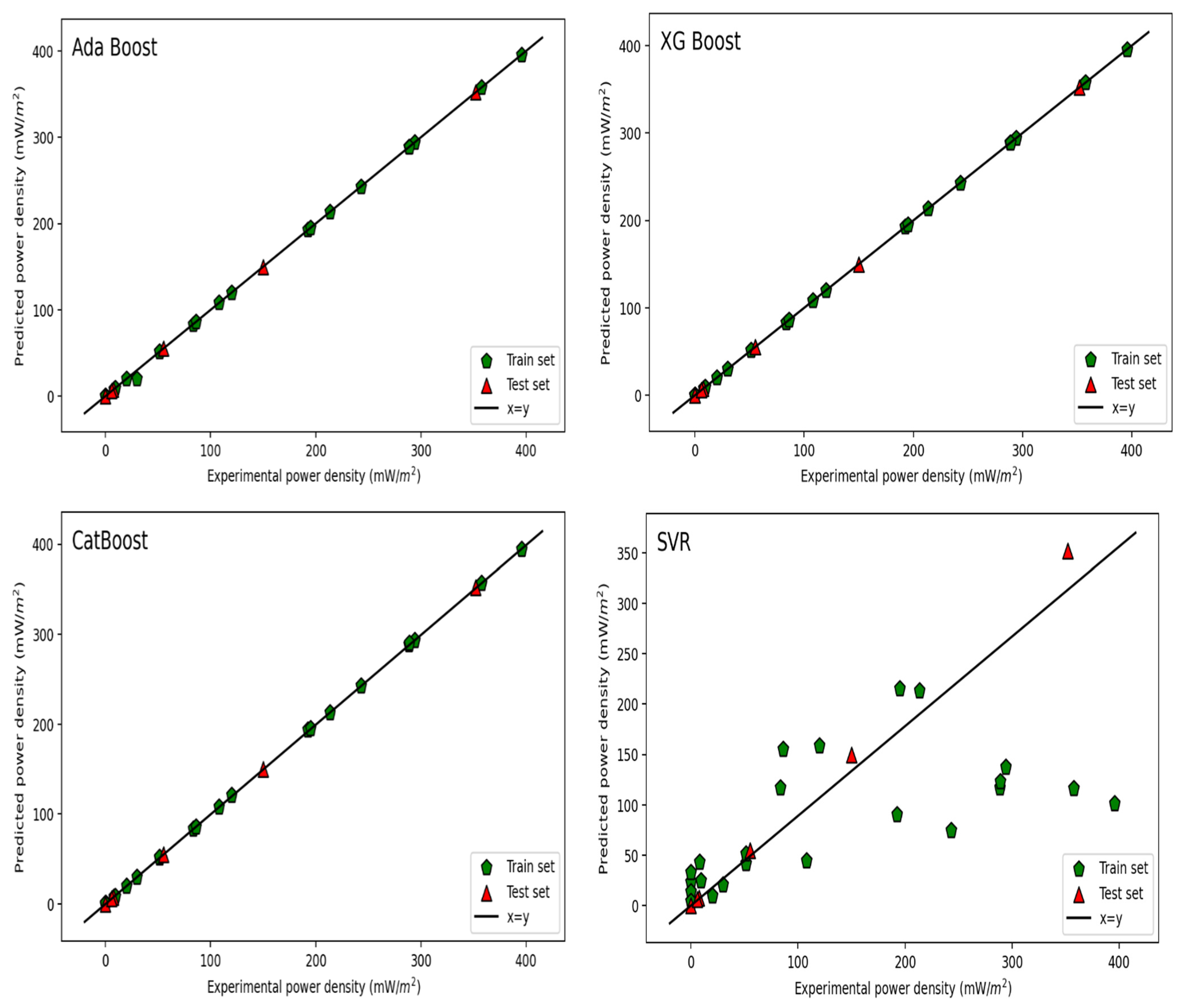
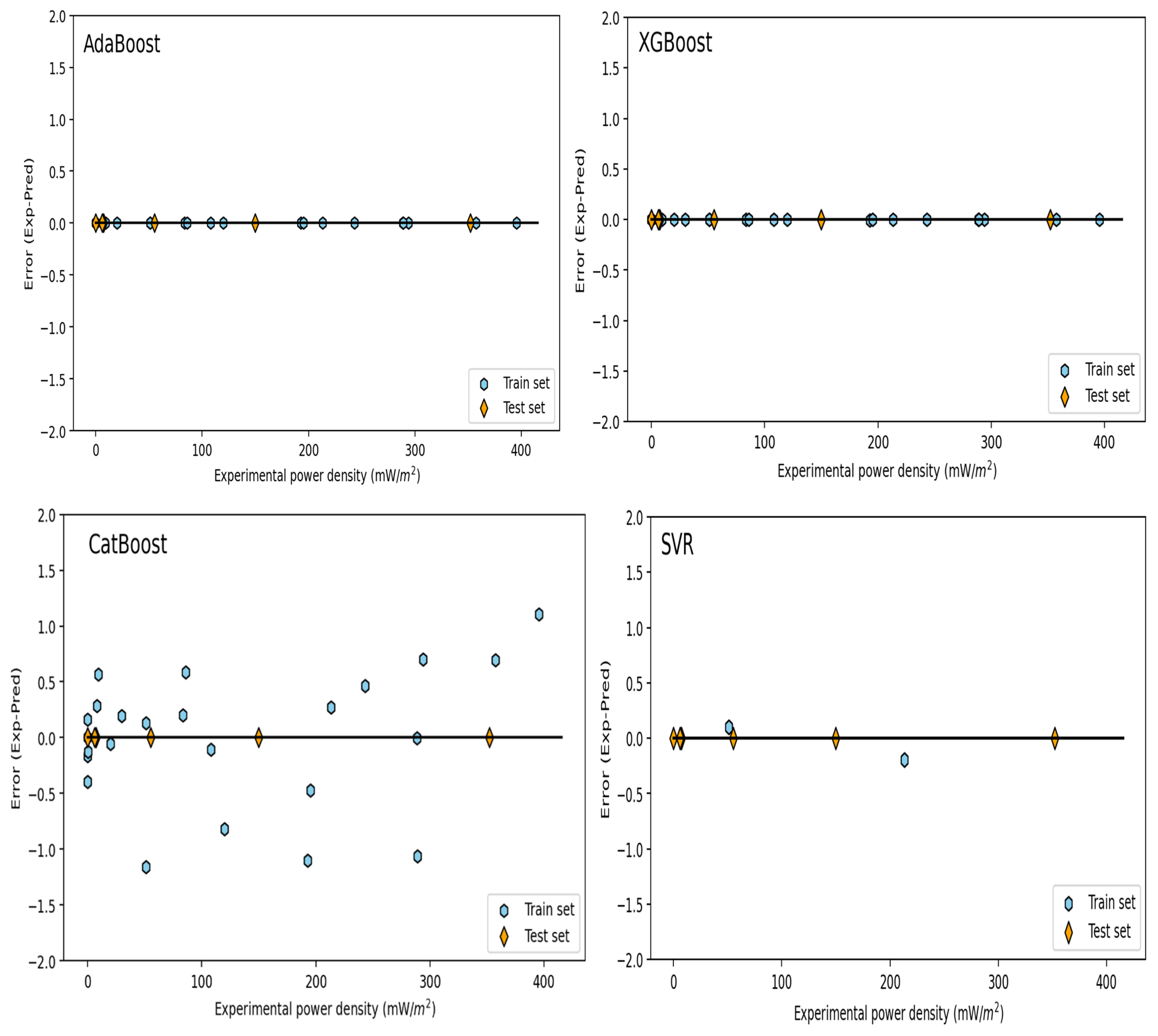
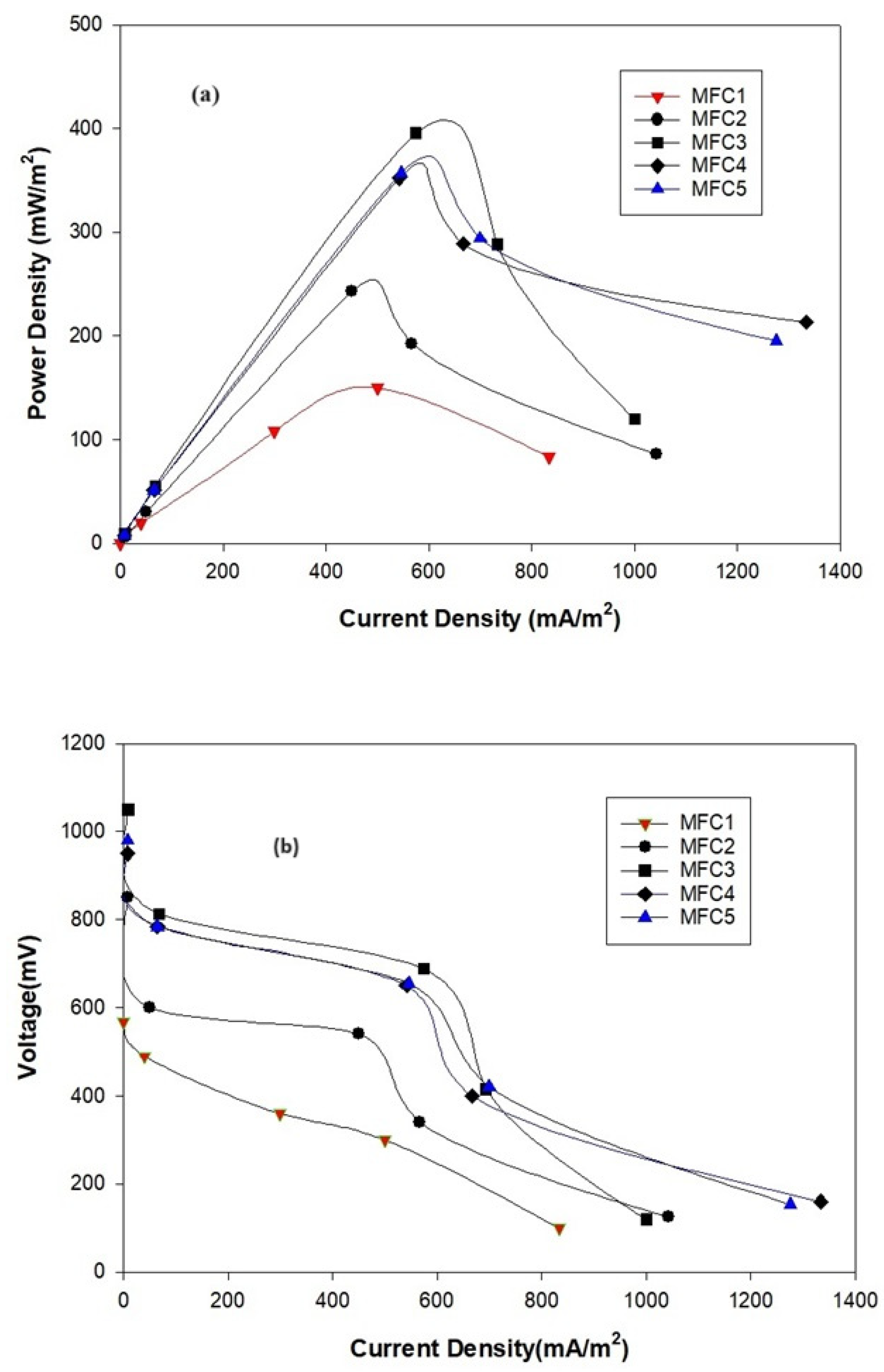
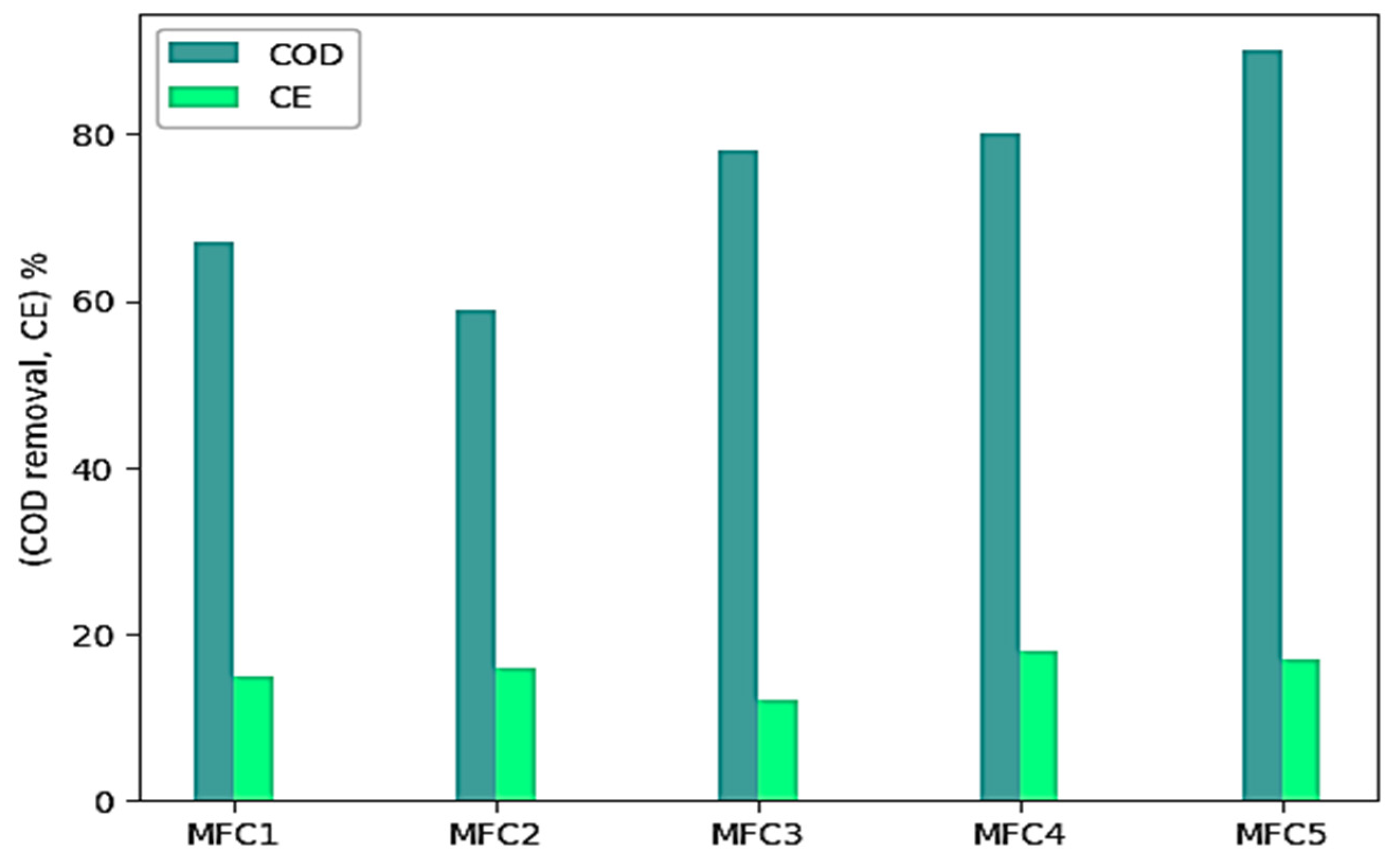
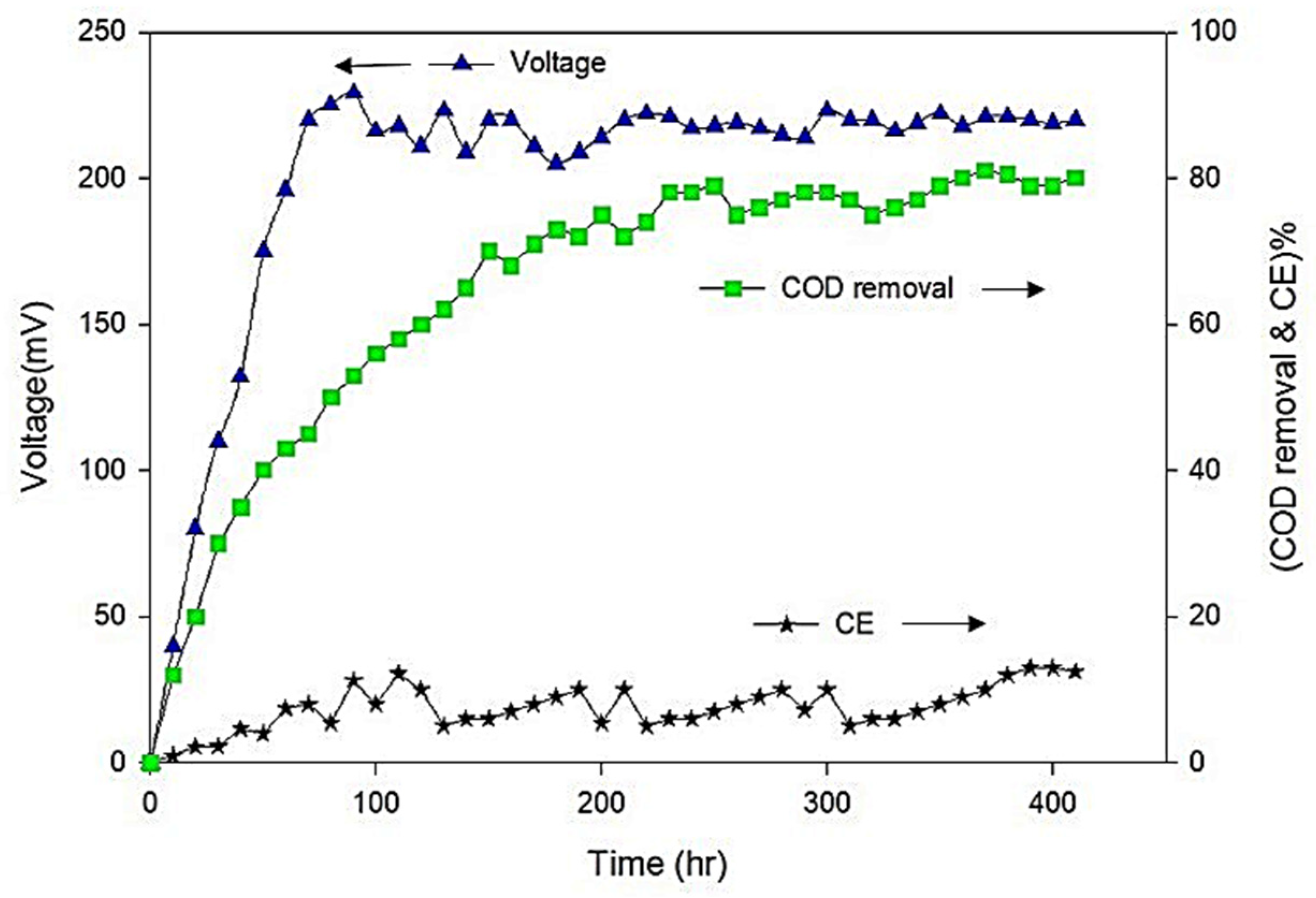
| Model | Hyperparameter | Search Range | Optimum Value |
|---|---|---|---|
| AdaBoost | n_estimators | 1–2000 | 40 |
| max_depth | 1–16 | 6 | |
| Learing_rate | 0.01–0.9 | 0.1 | |
| loss | linear, square, exponential | linear | |
| XGBoost | n_estimators | 1–2000 | 150 |
| max_depth | 1–20 | 5 | |
| Learing_rate | 0.01–0.9 | 0.1 | |
| min_child_weight | 1–4 | 2 | |
| Subsample | 0.1–1 | 0.2 | |
| CatBoost | n_estimators | 1–2000 | 100 |
| max_depth | 1–10 | 3 | |
| Learing_rate | 0.1–0.9 | 0.1 | |
| Subsample | 0.1–1 | 0.3 | |
| SVR | Kernel function | linear, polynomial, radial basis function | linear |
| gamma | scale, auto, float | scale |
| Rank | Model | Data | R2 | RMSE |
|---|---|---|---|---|
| 1 | XGBoost | Train | 1.000 | 0.003 |
| Test | 0.894 | 40.997 | ||
| Total | 1.000 | 0.002 | ||
| 2 | CatBoost | Train | 0.999 | 1.079 |
| Test | 0.893 | 41.277 | ||
| Total | 0.999 | 2.359 | ||
| 3 | AdaBoost | Train | 0.999 | 7.113 |
| Test | 0.861 | 32.641 | ||
| Total | 0.999 | 0.002 | ||
| 4 | SVR | Train | 0.284 | 179.772 |
| Test | 0.397 | 97.877 | ||
| Total | 0.999 | 2.359 |
| Vitamin Solution (mL/m2) | Current Density (mA/m2) | Power Density (mW/m2) | COD Removal (%) | Coulombic Efficiency (%) | |
|---|---|---|---|---|---|
| Optimal values | 5.8 | 576.8 | 395.6 | 78 | 12 |
| Validation | 5.80 | 581.4 | 397.6 | 79.5 | 11.85 |
| Error % | - | 0.79 | 0.50 | 1.89 | 1.27 |
Disclaimer/Publisher’s Note: The statements, opinions and data contained in all publications are solely those of the individual author(s) and contributor(s) and not of MDPI and/or the editor(s). MDPI and/or the editor(s) disclaim responsibility for any injury to people or property resulting from any ideas, methods, instructions or products referred to in the content. |
© 2024 by the authors. Licensee MDPI, Basel, Switzerland. This article is an open access article distributed under the terms and conditions of the Creative Commons Attribution (CC BY) license (https://creativecommons.org/licenses/by/4.0/).
Share and Cite
Farahani, H.; Ghasemi, M.; Sedighi, M.; Raut, N. Employing Artificial Intelligence for Enhanced Microbial Fuel Cell Performance through Wolf Vitamin Solution Optimization. Sustainability 2024, 16, 6468. https://doi.org/10.3390/su16156468
Farahani H, Ghasemi M, Sedighi M, Raut N. Employing Artificial Intelligence for Enhanced Microbial Fuel Cell Performance through Wolf Vitamin Solution Optimization. Sustainability. 2024; 16(15):6468. https://doi.org/10.3390/su16156468
Chicago/Turabian StyleFarahani, Hamed, Mostafa Ghasemi, Mehdi Sedighi, and Nitin Raut. 2024. "Employing Artificial Intelligence for Enhanced Microbial Fuel Cell Performance through Wolf Vitamin Solution Optimization" Sustainability 16, no. 15: 6468. https://doi.org/10.3390/su16156468
APA StyleFarahani, H., Ghasemi, M., Sedighi, M., & Raut, N. (2024). Employing Artificial Intelligence for Enhanced Microbial Fuel Cell Performance through Wolf Vitamin Solution Optimization. Sustainability, 16(15), 6468. https://doi.org/10.3390/su16156468








